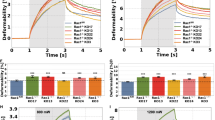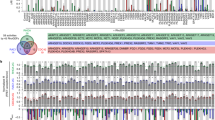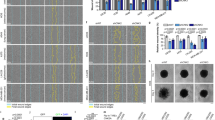Abstract
We describe an approach to selectively activate a kinase in a specific protein complex or at a specific subcellular location within living cells and within minutes. This reveals the effects of specific kinase pathways without time for genetic compensation. The new technique, dubbed rapamycin-regulated targeted activation of pathways (RapRTAP), was used to dissect the role of Src kinase interactions with FAK and p130Cas in cell motility and morphodynamics. The overall effects of Src activation on cell morphology and adhesion dynamics were first quantified, without restricting effector access. Subsets of Src-induced behaviors were then attributed to specific interactions between Src and the two downstream proteins. Activation of Src in the cytoplasm versus at the cell membrane also produced distinct phenotypes. The conserved nature of the kinase site modified for RapRTAP indicates that the technique can be applied to many kinases.
This is a preview of subscription content, access via your institution
Access options
Subscribe to this journal
Receive 12 print issues and online access
$259.00 per year
only $21.58 per issue
Buy this article
- Purchase on Springer Link
- Instant access to full article PDF
Prices may be subject to local taxes which are calculated during checkout




Similar content being viewed by others
Change history
07 April 2014
In the version of this article initially published online, the colors of the purple (SH2 mutant + FAK-FRB) and green (SH2 mutant + p130Cas-FRB) curves in Figure 3d were swapped, leading to a mislabeling of the two experimental results. The error has been corrected for the PDF and HTML versions of this article.
References
Thomas, S.M. & Brugge, J.S. Cellular functions regulated by Src family kinases. Annu. Rev. Cell Dev. Biol. 13, 513–609 (1997).
Frame, M.C. Src in cancer: deregulation and consequences for cell behaviour. Biochim. Biophys. Acta 1602, 114–130 (2002).
Playford, M.P. & Schaller, M.D. The interplay between Src and integrins in normal and tumor biology. Oncogene 23, 7928–7946 (2004).
Cross, F.R., Garber, E.A., Pellman, D. & Hanafusa, H. A short sequence in the p60src N terminus is required for p60src myristylation and membrane association and for cell transformation. Mol. Cell. Biol. 4, 1834–1842 (1984).
Buss, J.E., Kamps, M.P. & Sefton, B.M. Myristic acid is attached to the transforming protein of Rous sarcoma virus during or immediately after synthesis and is present in both soluble and membrane-bound forms of the protein. Mol. Cell. Biol. 4, 2697–2704 (1984).
Dhar, A. & Shukla, S.D. Involvement of pp60c-src in platelet-activating factor-stimulated platelets. Evidence for translocation from cytosol to membrane. J. Biol. Chem. 266, 18797–18801 (1991).
Weernink, P.A. & Rijksen, G. Activation and translocation of c-Src to the cytoskeleton by both platelet-derived growth factor and epidermal growth factor. J. Biol. Chem. 270, 2264–2267 (1995).
Resh, M.D. & Erikson, R.L. Highly specific antibody to Rous sarcoma virus src gene product recognizes a novel population of pp60v-src and pp60c-src molecules. J. Cell Biol. 100, 409–417 (1985).
Calothy, G. et al. The membrane-binding domain and myristylation of p60v-src are not essential for stimulation of cell proliferation. J. Virol. 61, 1678–1681 (1987).
Brown, M.T. & Cooper, J.A. Regulation, substrates and functions of src. Biochim. Biophys. Acta 1287, 121–149 (1996).
Webb, D.J. et al. FAK-Src signalling through paxillin, ERK and MLCK regulates adhesion disassembly. Nat. Cell Biol. 6, 154–161 (2004).
Shin, N.Y. et al. Subsets of the major tyrosine phosphorylation sites in Crk-associated substrate (CAS) are sufficient to promote cell migration. J. Biol. Chem. 279, 38331–38337 (2004).
Karginov, A.V., Ding, F., Kota, P., Dokholyan, N.V. & Hahn, K.M. Engineered allosteric activation of kinases in living cells. Nat. Biotechnol. 28, 743–747 (2010).
Karginov, A.V. & Hahn, K.M. Allosteric activation of kinases: design and application of RapR kinases. Curr. Prot. Cell Biol. 53, 14.13 (2011).
Kmiecik, T.E. & Shalloway, D. Activation and suppression of pp60c-src transforming ability by mutation of its primary sites of tyrosine phosphorylation. Cell 49, 65–73 (1987).
Berginski, M.E., Vitriol, E.A., Hahn, K.M. & Gomez, S.M. High-resolution quantification of focal adhesion spatiotemporal dynamics in living cells. PLoS ONE 6, e22025 (2011).
Bjorge, J.D., Jakymiw, A. & Fujita, D.J. Selected glimpses into the activation and function of Src kinase. Oncogene 19, 5620–5635 (2000).
Sandilands, E., Brunton, V.G. & Frame, M.C. The membrane targeting and spatial activation of Src, Yes and Fyn is influenced by palmitoylation and distinct RhoB/RhoD endosome requirements. J. Cell Sci. 120, 2555–2564 (2007).
Kamps, M.P., Buss, J.E. & Sefton, B.M. Mutation of NH2-terminal glycine of p60src prevents both myristoylation and morphological transformation. Proc. Natl. Acad. Sci. USA 82, 4625–4628 (1985).
Pellman, D., Garber, E.A., Cross, F.R. & Hanafusa, H. Fine structural mapping of a critical NH2-terminal region of p60src. Proc. Natl. Acad. Sci. USA 82, 1623–1627 (1985).
Schaller, M.D. et al. Autophosphorylation of the focal adhesion kinase, pp125FAK, directs SH2-dependent binding of pp60src. Mol. Cell. Biol. 14, 1680–1688 (1994).
Nakamoto, T., Sakai, R., Ozawa, K., Yazaki, Y. & Hirai, H. Direct binding of C-terminal region of p130Cas to SH2 and SH3 domains of Src kinase. J. Biol. Chem. 271, 8959–8965 (1996).
Cary, L.A., Han, D.C., Polte, T.R., Hanks, S.K. & Guan, J.L. Identification of p130Cas as a mediator of focal adhesion kinase–promoted cell migration. J. Cell Biol. 140, 211–221 (1998).
Parsons, J.T., Horwitz, A.R. & Schwartz, M.A. Cell adhesion: integrating cytoskeletal dynamics and cellular tension. Nat. Rev. Mol. Cell Biol. 11, 633–643 (2010).
Gustavsson, A., Yuan, M. & Fallman, M. Temporal dissection of β1-integrin signaling indicates a role for p130Cas-Crk in filopodia formation. J. Biol. Chem. 279, 22893–22901 (2004).
Dagliyan, O. et al. Rational design of a ligand-controlled protein conformational switch. Proc. Natl. Acad. Sci. USA 110, 6800–6804 (2013).
Choi, J. et al. Phosphorylation of stargazin by protein kinase A regulates its interaction with PSD-95. J. Biol. Chem. 277, 12359–12363 (2002).
Chen, L. et al. Stargazin regulates synaptic targeting of AMPA receptors by two distinct mechanisms. Nature 408, 936–943 (2000).
Tsygankov, D. et al. CellGeo: a computational platform for the analysis of shape changes in cells with complex geometries. J. Cell Biol. 204, 443–460 (2014).
Lee, D.T. Medial axis transformation of a planar shape. IEEE Trans. Pattern Anal. Mach. Intell. 4, 363–369 (1982).
Blum, H. in Models for the Perception of Speech and Visual Form (ed. Dunn, W.W.) 362–380 (MIT Press, 1967).
Chin, F., Snoeyink, J. & Wang, C.A. Finding the medial axis of a simple polygon in linear time. Discrete Comput. Geom. 21, 405–420 (1999).
Aichholzer, O. et al. Medial axis computation for planar free-form shapes. Comput. Aided Des. 41, 339–349 (2009).
Wu, C. et al. Arp2/3 is critical for lamellipodia and response to extracellular matrix cues but is dispensable for chemotaxis. Cell 148, 973–987 (2012).
Acknowledgements
We thank B. Clarke for help with figures and are grateful to the US National Institutes of Health for funding (R21CA159179 to A.V.K., GM102924 and GM094663 to K.M.H. and GM079271 to T.C.E.).
Author information
Authors and Affiliations
Contributions
A.V.K. and K.M.H. initiated the project, and A.V.K. carried out the bulk of the experimental studies. D.T. and T.C.E. developed and applied the new method used to analyze filopodia dynamics. M.B. and S.G. quantified cell adhesion dynamics. All of the other morphodynamic quantifications were by D.T. and A.V.K. E.D.T. and P.-H.C. assisted with kinase assays and cloning. J.J.Y. provided mCherry-stargazin. All of the authors contributed to the writing of the manuscript.
Corresponding author
Ethics declarations
Competing interests
The authors declare no competing financial interests.
Supplementary information
Supplementary Text and Figures
Supplementary Results and Supplementary Figures 1–31. (PDF 9898 kb)
Supplementary Video 1
Effect of RapR-Src activation on cell spreading. (MOV 4182 kb)
Supplementary Video 2
Activation of RapR-Src stimulates cell spreading and filopodia formation. (MOV 755 kb)
Supplementary Video 3
Effect of RapR-Src activation on focal adhesions (MOV 865 kb)
Supplementary Video 4
Effect of RapR-Src activation on focal adhesions (using different focal adhesion marker). (MOV 320 kb)
Supplementary Video 5
Effect of RapR-Src activation at the membrane (MOV 695 kb)
Supplementary Video 6
Effect of RapR-Src activation in the cytoplasm. (MOV 738 kb)
Supplementary Video 7
Effect of RapR-Src activation in complex with FAK on focal adhesions. (MOV 636 kb)
Rights and permissions
About this article
Cite this article
Karginov, A., Tsygankov, D., Berginski, M. et al. Dissecting motility signaling through activation of specific Src-effector complexes. Nat Chem Biol 10, 286–290 (2014). https://doi.org/10.1038/nchembio.1477
Received:
Accepted:
Published:
Issue Date:
DOI: https://doi.org/10.1038/nchembio.1477
This article is cited by
-
Engineering proteins for allosteric control by light or ligands
Nature Protocols (2019)
-
Development and application of bond cleavage reactions in bioorthogonal chemistry
Nature Chemical Biology (2016)
-
Erratum: Corrigendum: Dissecting motility signaling through activation of specific Src-effector complexes
Nature Chemical Biology (2014)



